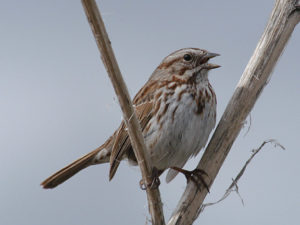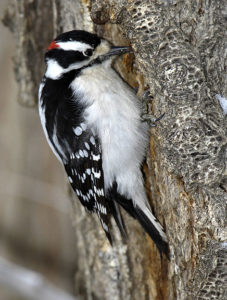This was the first bird walk I’ve led since back in early March. There were nine of us counting me, and we all adhered to strict corvid guidelines: masks, distancing, no shared spotting scope, etc. I thought it went well, and I felt fortunate to have had a good cooperative group.
So, first of all, what did we fail to see? Well, probably a lot of things, but what struck me the most is that we had no Canada Geese, Wood Ducks, raptors, Belted Kingfishers, or Bushtits. These tend to be regularly occurring species at the Gardens, but we whiffed on ‘em this time. I was particularly disappointed that we didn’t get to see any Wood Ducks as they have been regular breeders on the long turtle pond the last few years.
For the most part we saw species that we can expect to see in the area, and we focused on the vocalizations of a few of these. Song Sparrows are common and widespread across all of North America and are found year-round here in Colorado most commonly in moist shrubby habitats. As with all the Passerines, that is the birds that take up roughly the second half of your field guide, Song Sparrows have a “call” that they do throughout the year (some say it is akin to the bark of a Chihuahua) – first recording below, and then they have a “”song” that is heard primarily during breeding season (territoriality and attracting a mate) – second recording.
Another bird that we heard singing a lot were the Yellow Warblers. As they are neotropical migrants, they are only here in Colorado from May through mid-September. Their call is a simple “chip” note, while their song tends to be a version of “sweet-sweet-sweet-little more sweet.”
Also, one other bird we heard was the diminutive Downy Woodpecker which is found year-round in Colorado. It has a couple of calls; one is a sharp “pik” note, but the one we heard a few times was the descending whinny.
Finally, we had three rather special encounters for the morning. First, we got to see a family of four Say’s Phoebes hanging out together – three on top of same electrical box. Then, we had a pair of Gray Catbirds meowing. And, finally, we had a troop of Cedar Waxwings who literally came within a few feet of us, and we got great looks of the red-tipped wings and beautiful yellow-tipped tail. They are quite an eyeful!
Just a quick reminder that my favorite field guide for our area is The Sibley Field Guide to Birds of Western North America, which you can buy at the Front Range Birding Company (303-979-2473). Sibley also has a great app – Sibley Birds 2ndEdition, which has a nice variety of vocalizations as well as the other info found in the field guide.
Oops! One more thing: a Canada Goose egg is 86 x 58 mm, Great Blue Heron is 65 x 46 mm, and a Mallard is 58 x 42 mm.
Good birding!
Chuck
Hudson Gardens, Jun 27, 2020
33 species
Mallard 16
Rock Pigeon (Feral Pigeon) 1
Eurasian Collared-Dove 1
Mourning Dove 4
Double-crested Cormorant 7
American White Pelican 8
Great Blue Heron 1
Snowy Egret 1
Downy Woodpecker 3
Northern Flicker 9
Western Wood-Pewee 2
Say’s Phoebe 4
Warbling Vireo 1
Blue Jay 1
Black-billed Magpie 1
Black-capped Chickadee 12
Tree Swallow 3
Barn Swallow 5
Cliff Swallow 15
White-breasted Nuthatch 2
House Wren 2
Gray Catbird 2
American Robin 17
Cedar Waxwing 11
House Finch 4
Lesser Goldfinch 1
American Goldfinch 5
Song Sparrow 3
Bullock’s Oriole 3
Red-winged Blackbird 14
Brown-headed Cowbird 3
Common Grackle 10
Yellow Warbler 17






Comments
Write Comment